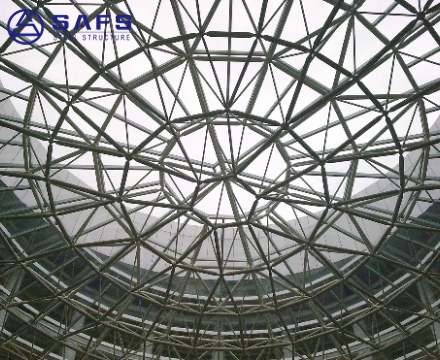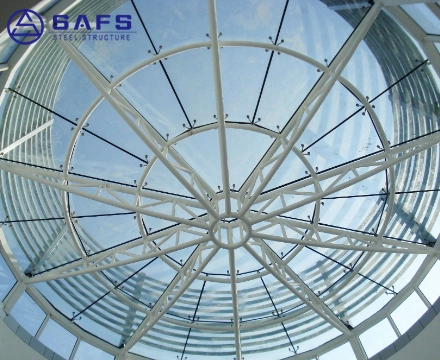Dapeng Town Industrial Park, Tongshan District, Xuzhou City, Jiangsu Province, China
The “dome”, a special role in the history of architecture, plays a role far beyond the technology itself because of its huge span and striking shape. It is also known as the safest dome structure in science, with a rounded interior that gives people a sense of comfort as if they were nestled in their mother’s arms.
There are two general interpretations one is the overhanging hemispherical space or area, the other is the apex or top of a dome or dome shaped surface (such as a street or bridge towards the central round arch), specifically referring to the difference in height between the center of the road of a round arch and its edges.
Design requirements for steel structure daylighting roofs and domes:

1. closed-end profiles are suitable for end-sealing treatment; the thickness of the coating film should not be less than 35um when spraying with light-harvesting fluorocarbon paint or polyester paint, and the thickness of the coating film should not be less than um in serious air pollution and seaside areas;
2. the main force members and connections should be used wall thickness of not less than mm steel plate, wall thickness of not less than 2.5mm hot track steel pipe, size not less than 45 * 4 or 56 * 36 * 4 angle steel and not less than 2mm cold-formed benton-wall section steel;
3. deflection requirements, the deflection of the panel support members should be less than 1/500 of its span, the deflection of the glass panel does not exceed 1/120. the deflection requirements of the support members see the relevant requirements of JGJ255;
4. It is desirable to use heat-insulating aluminum alloy profile or heat-insulating steel profile for the bright frame supporting structure.
1. The glass of the roof should be used safety glass (homogeneous tempering), it is desirable to use laminated glass and laminated insulating glass The original piece of glass can be selected according to the design requirements and the thickness of a single piece of glass should not be less than 6 mm, the original piece of glass of laminated glass should not be less than 5 mm. (The highest point of the glass of the roof to the ground or floor distance greater than 3 mm, should use laminated glass or laminated hollow)
2. The laminated silica glass used in the lighting roof should meet the requirements of GB 15763. 3, but also should meet the following requirements:
Laminated glass should be dry-processed synthetic laminated glass thickness difference between the two pieces of glass should not be greater than 2 mm; laminated glass limbs should be used polyvinyl butyrate (PVB) film PVB film thickness should not be less than 0. 76 mm; (with special requirements with polyvinyl methacrylate film); exposed to the air edge of the laminated glass should be sealed treatment.
3. The laminated insulating glass used in the lighting roof should comply with the relevant provisions of 6. 2. 3 and GB/T 11944 in addition to the following requirements:
a.The thickness of the gas layer of insulating glass should not be less than 12 mm;
b.Insulating glass should adopt the present sealing structure, and the second sealing of the hidden frame in the glass should adopt the silicon jailed structural sealant;
c.The laminated surface of the insulating glass should be on the lower surface of the insulating glass;
d.When the difference in altitude between the place of origin and the place of use or the place of transportation of insulating glass is more than 1 000 m, it is advisable to install capillary tubes or breathing tubes to balance the difference in air pressure inside and outside.
4. All light roof glass should be ground and chamfered.
5. Sun-shading requirements can be used to shade low-e coated laminated insulating glass.
